Brunello on the heights. Fashion or necessity?
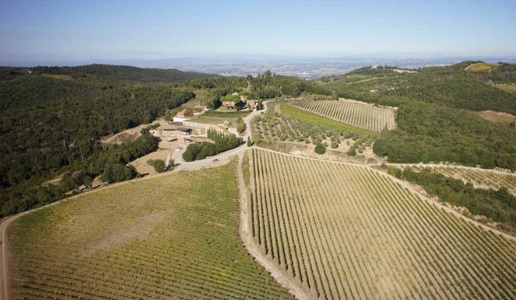
In the last years the debate about climate change is one of the most popular ones; in our world of wine lovers the discussion about vineyards becomes central.
Have the hierarchies of vineyards changed according to the new weather conditions? There is a tendency to say that the best vineyards are the higher ones because they are cooler and with less possibility of overripening because of their delay in ripening.
Like all the simple, immediate and intuitive solutions, this one is wrong as well, as the situation is much more complex, in particular if we place it in an important viticultural reality such as Montalcino. Sangiovese with the new clones introduced in the 1990's and following years has a maturation window which lasts about 6 months. The period which goes from the beginning of the veraison to the harvest changes a lot according to the area considered, leading in the most difficult or cold years to variations of almost one month between the hottest areas and the classically colder ones.
What should be emphasized is that unfortunately it is not so much the difference in temperature to create problems but the change in the rainfall pattern. In Montalcino, if one looks at the annual rainfall profile, what has changed a lot is not so much the total amount of rainfall per year but its distribution and this has created many problems for viticulture. In short, it rains wrong for the vines. Often there is a lack of August rains, the ones after mid-August, sometimes there is a lack of spring rains which helped plants to thrive and gave them a very useful water reserve.
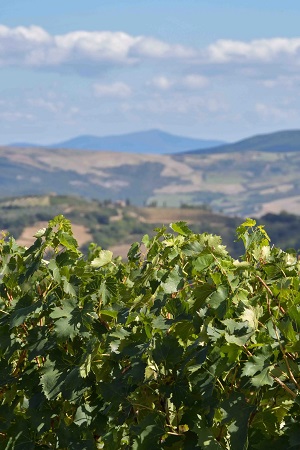 It is enough to consider this variable in order to understand that the problem cannot be solved by altitude, on the contrary, if the soil is draining, the higher you are and the more you are beaten by the wind, the more the problem becomes acute. Plants defend themselves from heat by closing their stomata, minimizing evaporation and waiting for better times; but if there is no water, the problem is much more serious.
It is enough to consider this variable in order to understand that the problem cannot be solved by altitude, on the contrary, if the soil is draining, the higher you are and the more you are beaten by the wind, the more the problem becomes acute. Plants defend themselves from heat by closing their stomata, minimizing evaporation and waiting for better times; but if there is no water, the problem is much more serious.
The wine grower who studies and updates himself has however cultivation techniques which allow him to face these situations thanks to careful soil management interventions, changing the tradition which in these cases turns out to be harmful because it is based on different problems. Also the management of the foliage helps a lot, especially towards and after veraison. Therefore I believe there is not a reversal in the quality of vineyards but an exaltation of the qualities of winemakers in better managing the vineyard.
Moreover the capacity of managing grapes in the winery still makes a difference much more than the climate change. In the last hot vintages 2012, extreme 2011 and 2007 the differences were made by men more than the position of vineyards.
Reflection will be done on new plantings where we will have a different use of rootstocks preferring the ones more prone to vertical growth even though they are exuberant, and also the choice of clones will be oriented to the ones which better tolerate drought. Probably, but in Montalcino they have never exaggerated, they will reason on the density of the plants.
New ideas are making their way, such as knowing how much water each bunch needs to ripen according to the position of the vineyard, at this point if the bunch is one or four per plant it seems to make a big difference for quality. But on this we are at the experimentation of very few producers.
In great vintages such as 2016 the hierarchies of the vineyards are the ones that have been consolidated for years, a sign that for now the hand, or better to say the head, of man is more important than other factors in making a difference.
The following are some Brunellos 2016 made at high altitude, which show peculiar characteristics and consistent with the position of their birth, but - despite being of excellent quality - did not find space in The Essential Guide 2022. Four are at the new high altitude level, two come from vineyards once considered high and now instead normal.
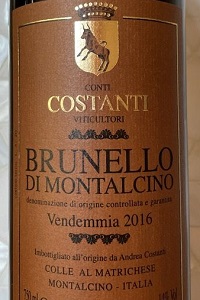 Brunello di Montalcino 2016 Costanti
Brunello di Montalcino 2016 Costanti
96/100 - € 90
The Brunello of Costanti, a historic winery of the area, in the 80's of the last century was considered of high altitude while now it is perceived as a normal position. The main difference with the other Brunellos from the "highlands" is the gustative texture which is thicker and tighter and allows the tannins, although young, to be less restless. Taste is less briny and the progression is more muscular. The wine is however elegant and saline with a traditional and fresh nose but more on ripe red fruit and yellow spices, with the typical solidity of Ilcinese genius loci.
100%Sangiovese grapes, it ages 48 months of which 18 in tonneaux, 18 in Slavonian oak casks and 12 in bottle.
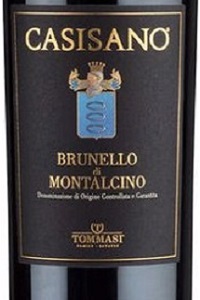 Brunello di Montalcino 2016 Casisano
Brunello di Montalcino 2016 Casisano
95/100 - € 45
This Brunello from the Tommasi family comes from the ridge leading to Castelnuovo dell'Abate from the Lume Spento pass.
Bright ruby red color, a classic intense aroma of yellow fruit, green spices and a clear undergrowth. The texture is quite dense with tannins that are churning but well-made. The progression is youthful and flavorful and the finish graceful, savory and very intense. A wine that plays his game on tannins rather than acidity.
100% Sangiovese grapes, it ages 3 years in 60 hl Slavonian oak casks and a minimum of 6 years in bottle.
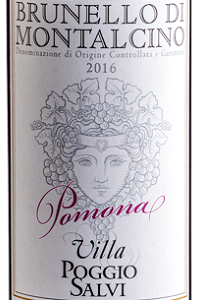 Brunello di Montalcino Pomona 2016 Villa Poggio Salvi
Brunello di Montalcino Pomona 2016 Villa Poggio Salvi
94/100 - € 60
We are in the western part of the northern ridge leading to Castiglion del Bosco.
A classic ruby red color, this Brunello has a variegated nose of fresh cherries, balsamic notes of winter woods and medicinal herbs. The flavor texture is medium with polished tannins, an elegant progression and no jolts. The finish is savory and persistent yet graceful.
100% Sangiovese grapes, it ages 30 months in 30 hl Slavonian oak casks and a minimum of 4 months in bottle.
 Brunello di Montalcino 2016 Le Potazzine
Brunello di Montalcino 2016 Le Potazzine
94/100 - € 76
On the same side as the previous one, this winery has been a reference for high altitude Brunellos for several years.
Slightly garnet ruby red color. Complex nose with medicinal herbs, red fruit and dark spices. Elegant flavor texture with refined tannins, a nice savory progression and a finish that recalls the fresher olfactory notes. Persistent, elegant and fresh.
100% Sangiovese grapes, it ages 40 months in 30-50 hl Slavonian oak barrels. Unfiltered.
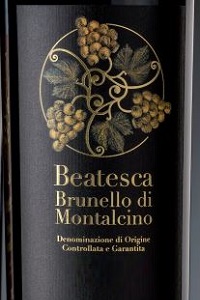 Brunello di Montalcino 2016 Beatesca
Brunello di Montalcino 2016 Beatesca
94/100 - € 70
A small winery with vineyards on 400/450 meters in the upper part therefore of Canalicchi, northern area of Montalcino. In 2016 it produced its best Brunello ever. Once it was high lying by Montalcino standards now instead it is very interesting.
Intense ruby red color. At the nose, the ripe fruit of blackberries and morello cherries, yellow spices. The taste texture although elegant is dense and with a juicy progression more than agile, the finish is intense and tasty.
100% Sangiovese grapes, it ages for 2 years in 50% new tonneaux and ages in bottle for other 2 years.
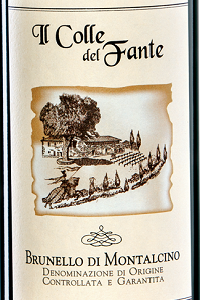 Brunello di Montalcino Il Colle del Fante 2016 Ventolaio
Brunello di Montalcino Il Colle del Fante 2016 Ventolaio
94/100 - € 60
We are along the ridge that leads from the Lume Spento pass to Castelnuovo dell'Abate, a fascinating and wild place.
Lightly garnet ruby red color. To the nose, yellow and white fruit, with touches of cherries, fresh spices and hints of tobacco. Ethereal flavor texture and resolute tannins find comfort in the distinct flavor. The progression is elegant, savory, almost rarefied but the finish is decidedly persistent.
100% Sangiovese grapes, it ages in large casks and tonneaux, then refined in bottle.

 Italiano
Italiano







